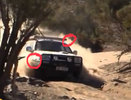- Location
- Vehicular limbo
I've never been a fan of snorkels, never wanted one on any of my trucks. Not that I doubt their effectiveness in the water, just that I've never ever been anywhere near a water depth that would require one and don't really intend to either.
But let's talk about this dust thing.
Yoinked these quotes from another thread:
I'd like to see a study done on the difference in dust levels between grill height and fender height when following another truck down the road. I strongly suspect that at a safe follow distance the difference is negligible, but I'm willing to be convinced.
But regarding the prefilter, looking at claims like these, I'm intrigued. I clean off a caked air filter after every trip (or, uh, I should clean off a caked air filter every trip... ). I would really love to have a good look at a pair of air filters after an identical trip, one from a stock intake and one behind one of these prefilters, or at least hear anecdotal evidence from those running them?
). I would really love to have a good look at a pair of air filters after an identical trip, one from a stock intake and one behind one of these prefilters, or at least hear anecdotal evidence from those running them?
But let's talk about this dust thing.
Yoinked these quotes from another thread:
Excuse? Auto/truck/tractor manufactures around the globe offer them OE, ever watch a Dakar desert rally? They are often designed specifically for clean/cool air, not water fording. Thus would be the case for the OE Toyota applications found around the world.
Ha! I always chuckled at folks who saw the factory snorkel on the mog and asked about going through water that deep. While the military did use the snorkel for water, truth be told, I suspect the original design had very little to do with fording rivers and more to do with the heritage as an agricultural implement. Most tractors have a snorkel and usually a cyclone prefilter like a unimog to eliminate dust and dirt from the intake air.
I'd like to see a study done on the difference in dust levels between grill height and fender height when following another truck down the road. I strongly suspect that at a safe follow distance the difference is negligible, but I'm willing to be convinced.
But regarding the prefilter, looking at claims like these, I'm intrigued. I clean off a caked air filter after every trip (or, uh, I should clean off a caked air filter every trip...



